Hold On, It’s a Bench!
I receive questions from woodworkers who start out with, “What’s your opinion of . . . ?” It might be a tool, a vise, a workbench type I have never used or used or never even heard of. Opinions are funny things in the same way assumptions very often are. When you find something that works for you then most likely there is no need to change anything without good reason. Higher degrees of engineering quality with less slop somewhere seems all the better to go for but often, well, no it’s not. I owned a vise that was highly engineered but too tight to move. My now ‘vintage’ planes bought new always had some slack in the take-up of threads and the sliding left or right of a lever. I have bought different versions of so-called high-end (and higher priced) tools like planes, chisels, saws and such to trial and use and ended up shelving all of them for different reasons. Most other such buyers started swearing by them and of course gurus slip their hands into or around the handles as much as a statement as they do advocacy for others to buy into them too. When you spend a few thousand on such tools to start woodworking then you better use them or you’ll have some explaining to do to others around you watching your range of investments.
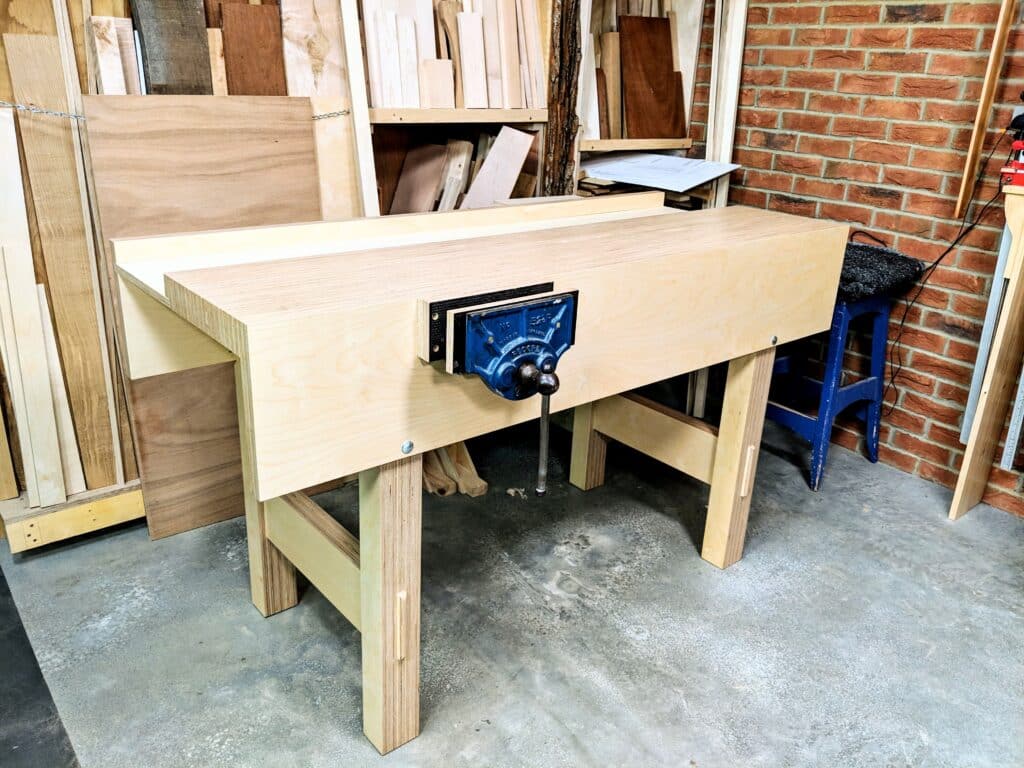
The only bought benches from my youth were the commercially made school woodworking benches. I grew up with joiner’s workbenches which were made by the joiners using them or their forefathers in the trade. Back then the only Bailey-pattern planes were made by Stanely or Record. For some reason, I still cannot fathom, joiners kept some Scottish-made infil planes near to hand but never used them. I am guilty of owning some and not using them and the reason is simple. One, they’re too heavy and cumbersome and, two, they don’t work any better if as well as the Stanley alternatives. That said, the ones I own were indeed extremely well-used. I suspect this to be because they predate the emergence of the Bailey-pattern versions in the 1860s, the shunning of them at the start and then these users liked the idea of steel soles because of longevity. But weight and bearing down over a plane to maximise pressure seems to be a common teaching from some modern gurus. Working ‘overhead’ supposedly works better but that is far from true and I might suggest my suspicion that a lazy attitude to sharpening their planes on time or well enough might be nearer the truth. A well-adjusted and sharp plane pulls itself to the surface unquestioningly. Using force in downward pressure reflects the neglect of the user in one way or another mostly. We really should not forget that the more you press down on a plane the more you will increase friction to cause drag on the plane. It’s one thing applying wax or oil to the sole to ease the friction but for 95% of the work, this should be unnecessary and especially with the lightweight planes given us by Leonard Bailey.
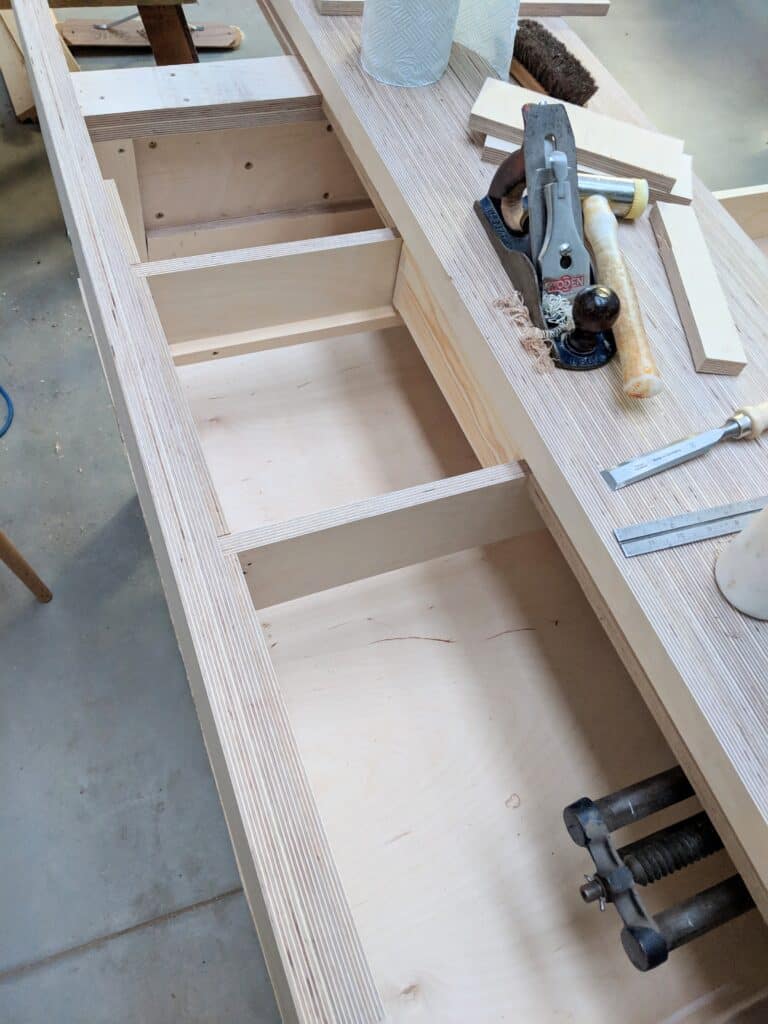
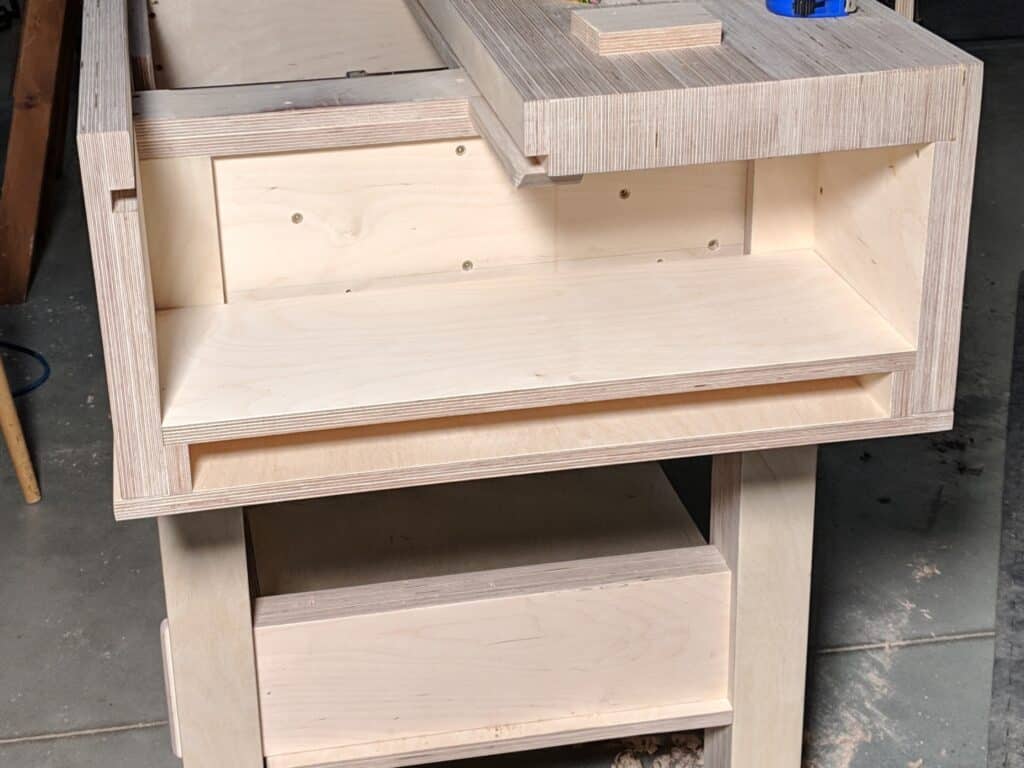
Workbenches have indeed needed change through the more recent decades. I went to a woodworking school in a college a few years ago where I was invited to inspect the commercial workbenches. The massive behemoths occupied a footprint three times the size they needed to and all because of the perceived maxim that bigger is best when It comes to workbenches. The head of woodworking proudly stood with his prizes, perhaps expecting a little more from me than he got. It was sad really because he obviously knew very little about what was needed which was twice as much free space for working and a bench design a third or even less than the size extolled. He really needed benches that could be moved around according to the needs of the classes; something two people can push from here to there is a good size and even though joinery benches should be larger they do not need to be heavier than is reasonable. In a training facility it makes much greater sense to move benches together rather than hog space with a surface that is 50% and often more unused. But with some people, mass and weight are all they understand: Matching a bench to the space and weight to the work would be more critical. I was generous with my comments because after-sales is always hard to correct when you’ve just spent a ton of unnecessary money. Anyway, what would have been far, far more impressive would have been to see woodworking benches made in-house by the second-year students. Now that would have been something to see and to endorse. I have yet to visit an institution with homemade workbenches. I think that that reflects the lack of vision by colleges more than anything.
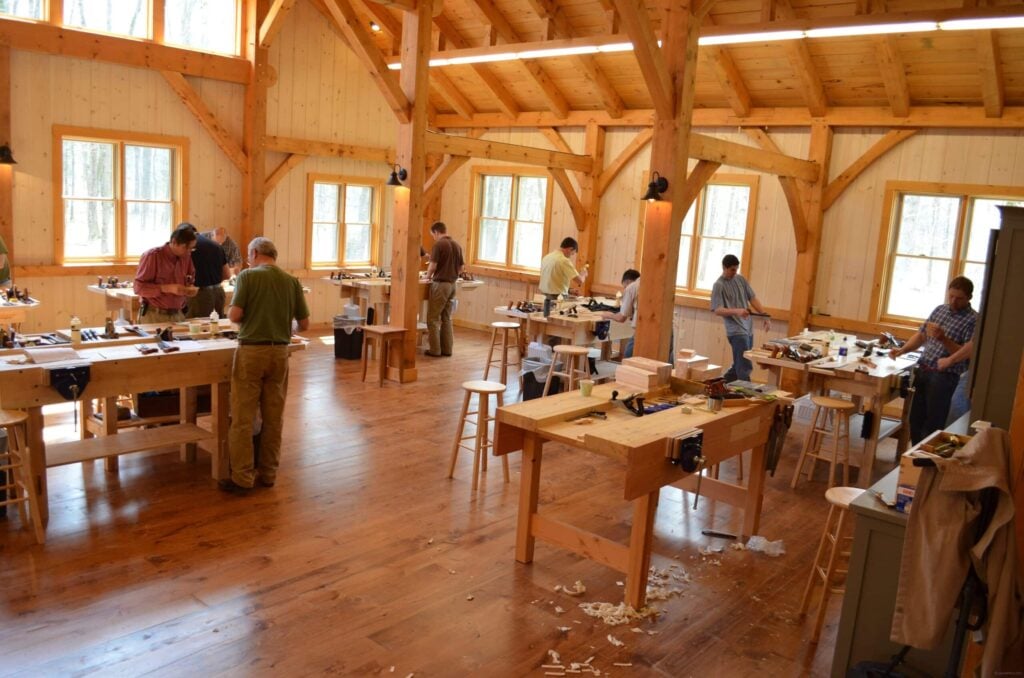
Your workbench needs to fit your space be that a garage, shed, attic or basement workshop and yet it still need not be massive even if you have an aircraft hangar. My workbenches for everything I do are resolved at between 5′ to 5’6″ long and two feet deep. Any bigger and it just fills with junk, believe me. In my garage workshop, I cannot have a centrally placed workbench to work either side from because of space. It must go against a facing wall. But I can manoeuvre it to turn around or place one end against a wall to have it 90º to the long axis of the garage as needed. Anyone watching my videos will have seen me reposition for projects that need different space.
There are those who suggest mini benches atop regular benches. I think that this is likely a good idea to cater to inability and disability. I have never in my 58 years needed a range of bench heights to expedite my work nor any bench-on-bench mini versions. And more than one bench is a luxury I can ill afford, but even if I could I would probably not do it. That said, any disability can indeed change a situation and some will need an alternative to help them in different aspects of their work. I do not want any secondary options that often come from little more than something like an opinion rather than a practical working option or solution. Personally, I’ve had 6,500 woodworkers work using the same bench scenario I use and never had one complaint or suggestion for changing anything. It’s also worth noting here something I have never mentioned before: I gave out an extensive three-page questionnaire at the end of each class between 1995 and 2009, 14 years, asking three dozen questions about the class, the facilities, the hand tools and equipment and, yes indeed, the workbenches. How many that was I cannot say now but thousands would in no way be an exaggeration. Such was my intent to discover how my students felt about the teaching and all that went with it. In the end, we pulled that endeavour because we never had any need to make any changes to what we offered.
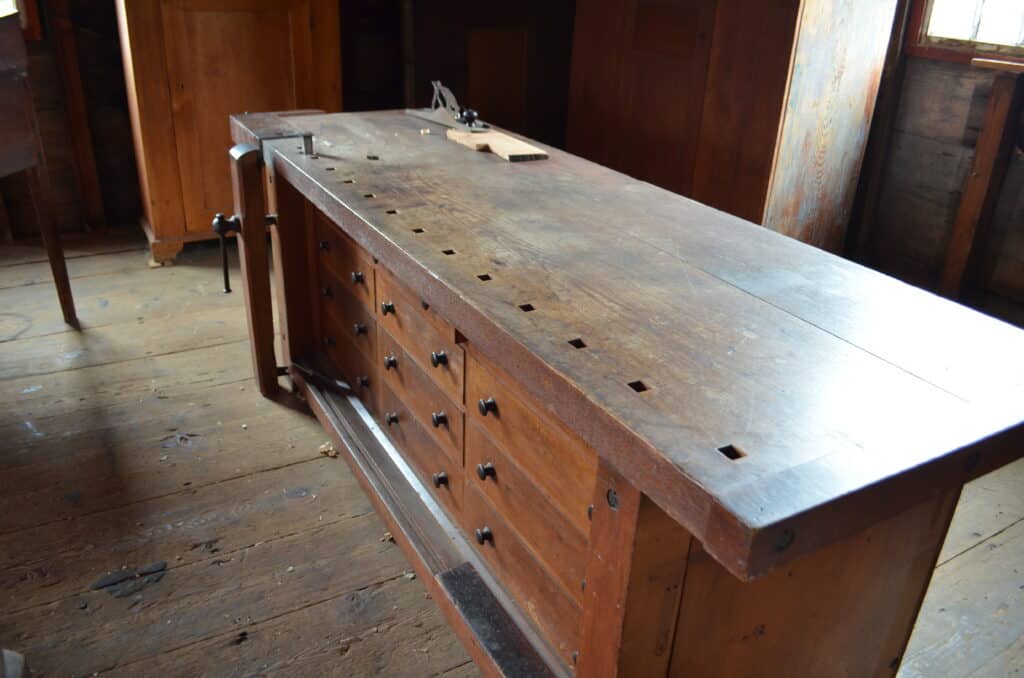
Tail vises are of little real value to me in any of my work. It’s an additional expense that offers very little or more likely nothing in return. I know, someone will comment that they use theirs all the time and cannot live without theirs. No matter. I think there is a certain pride that promotes advocacy for maximising options for a workbench thinking it to become more functional but I think that’s more that we might be looking for something to do rather than true need. I am sorry if this might seem a bit hard to some but it’s equally hard for me to just sit by and see an article come out saying this or that is a must-have. Workbenches do evolve but I have noticed with mine that it is more the keeping of tools close to hand rather than work-holding stuff. The two tail vises I have installed on two workbenches in my lifetime just increased the complexities of housing them and then the expense of buying them. And I found zero use for either of them in the end. The one I have left holds my electric cord neatly on the bar of the winding handle, nothing more.
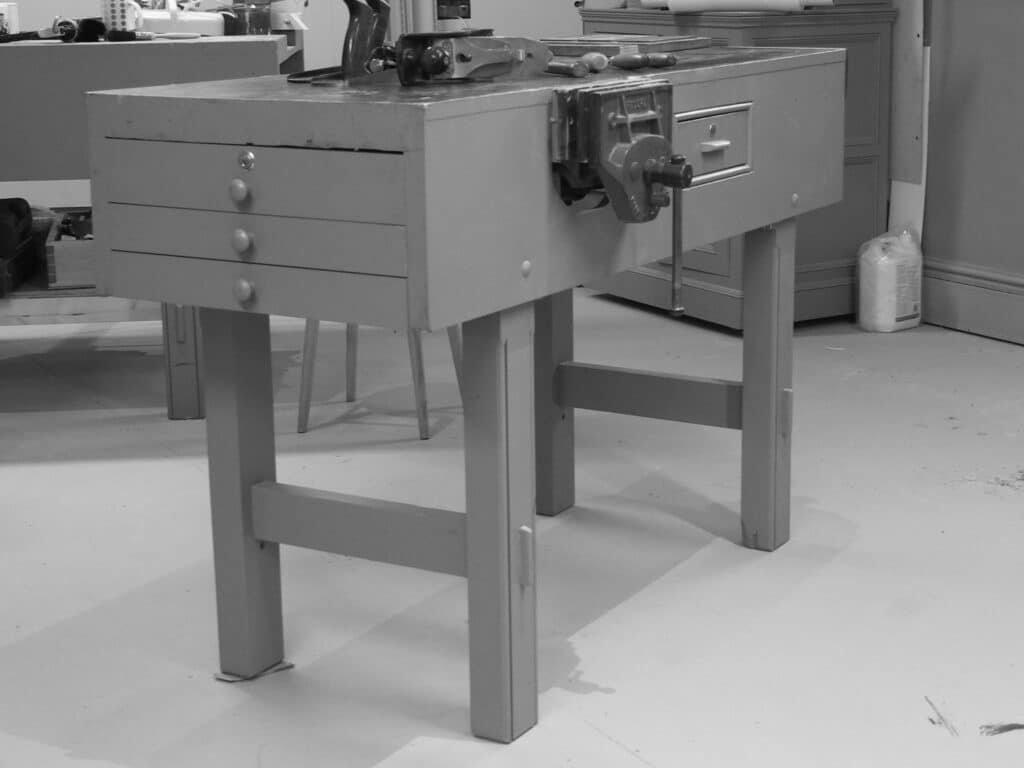
Inevitably, installing the tail vise introduces another addition to the workbench I don’t care for, dog holes. These holes scattered along or around the benchtop house bench dogs that work as stops opposing the vise closure to hold the work on the benchtop or take holdfasts to hold stuff to the benchtop. My solution is far more versatile and less invasive when I want to hold things to the benchtop for some types of work.
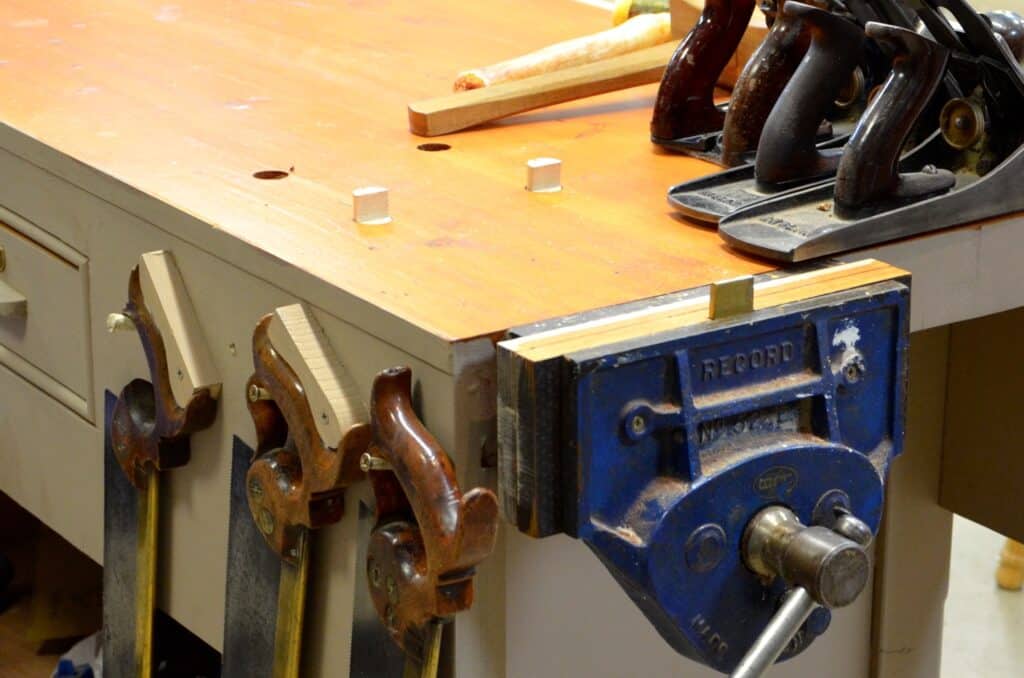
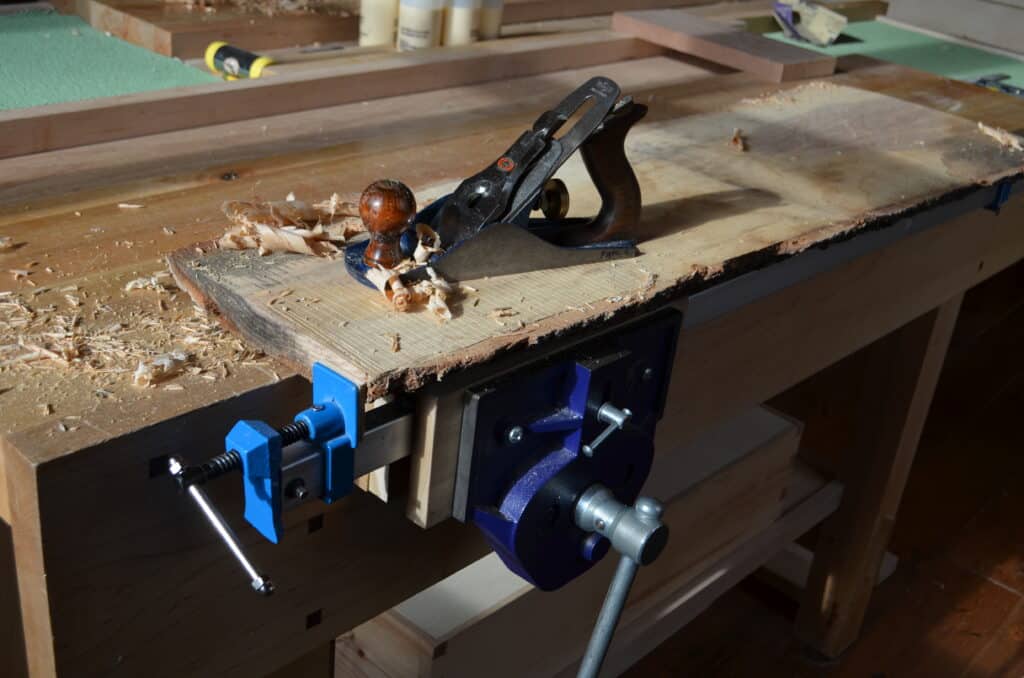
I generally use a shorter sash clamp held in the vise for anchoring things like tabletops and frames when they need to be planed and scraped or, dare I say it, belt sanded. This has to be the most comprehensive anchor point for holding anything and everything you can think of. Also. remember sash clamps will hold almost anything to the benchtop too so if you want to anchor a table leg for mortising it’s straightforward to apply a clamp or two. For sheet goods needing ripping or planks that need crosscutting, it’s the same.
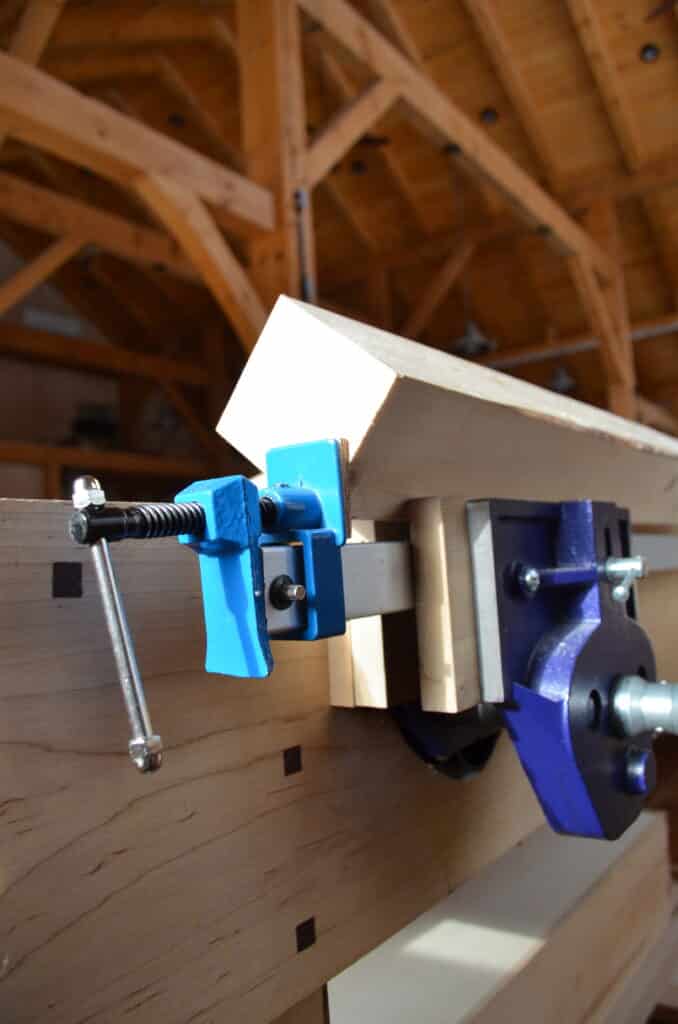
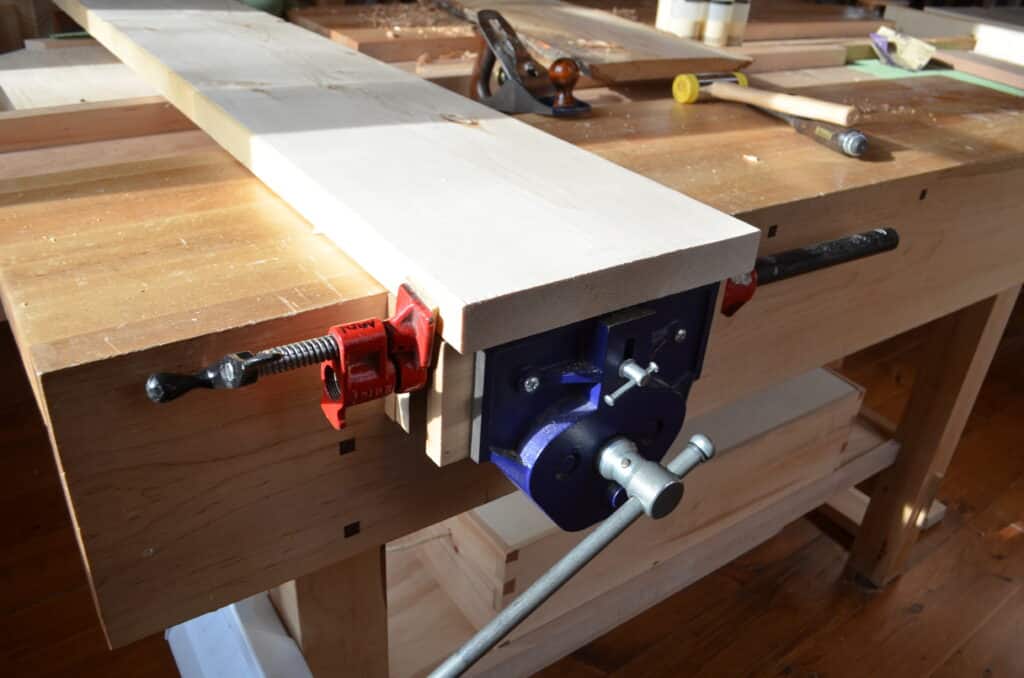


Paul, I’ve been curious lately about your approach to benches for a few reasons. 1-I dig your perceptions, whether your application works for me in my situation or not. You seem to have very well grounded perceptions and perspectives. 2- I’m a lifer carpenter, focusing mainly on woodwork the last several years. I have a commercial shop space with a 4×8 fab-table on wheels. A stow-a-way 3×5 work table and yeah of course all the power tools. I feel the hand-powered work calling me like my mama did 50 years ago though. I loving, getting to know the dynamics of the hand powered tools again. And the first thing I’m needing to improve in my space is the bench. I need a joiners bench of sorts. Because I’m mainly a 1 man operation and my projects are varied, I feel a modular design is needed. I’m leaning heavily toward the Moravian style bench. I very curious to know your perspectives on using that style bench?….. what is the reason for your not liking a flat top on a bench (am I understanding your correctly?….. and what is a sash clamp?
Thanks
-Ric
Sash clamps (UK) get their name from making sash windows, doors and door frames and so on so usually longer than the ‘C”, ‘F’ and ‘G’ clamps and many others. I have no opinion on bench styles beyond I think most people seem taken by looks and I think enjoy the idea of building their own workbench no matter the style.
Benches pretty much all work. Some styles work better for some than others. There are bench designs that lack any vise at all. Work holding is achieved with holdfasts and wedge systems. Most benches reflect some degree of specialization in some particular aspect of working with wood. The design Paul favors looks like a refined relative of benches that were commonly constructed on work sites where built in cabinetry and storage areas were a given. In the US benches like that were built right into the mid-20th century. In the 1920s and ’30s entire shops were sometimes transported to work sites, and trim, moldings, and cabinets were built on site, occasionally not remotely close to the high standards Paul applies.
Paul, I love your style and the simplicity of your ideas for sake of understanding! Are there measured drawings of your current workbench I might be able to view? Thanks!
I’d suggest putting a good cast iron vise to get started working so you know what you like and dislike
Did that on a 30mm flat top melamine workbench primarely designed for power tools because I needed to get things done in time
Now I can tell you even without having the chance to try a workbench designed for hand tools that a flat top melamine feels like a trampoline when chopping mortises and dovetails and everything will fall of your bench when you do
Casters, even blocking ones, will slide around and my back hurts after one hour of chisel work because it’s 10cm too low
Oh and the flat top melamine isn’t flat, I have about 1cm cup, nothing dramatic that can’t be worked around but it’s there
So yeah I’d suggest to stop over thinking and start working, you’ll feel what’s good for you
(Sash clamps are bar clamps I think)
I built the Moravian in ’21 and love it. The knockdown-ability of it is hard to beat.
I built a Moravian at about the same time as you. I had already built a “Paul Sellers” bench. I wanted something easily transportable but I didn’t realise quite how solid and stable the Moravian would be.
I’m needing to adjust the design as I build my own Paul Sellers Workbench. I tried to cut corners in preparing the bench top laminations so then in flattening the top I’ve had to take off more than I wanted and the top is now threatening to be under 2” thick. Lesson learned, but now I’m thinking about putting some cross supports in to support the middle of the top, which it looks like you did in that plywood workbench with the hidden toolbox. Would there be a possibility of a workbench customization video for that compartment?
My current workbench is two years away from its 40th birthday and the bench has evolved over the years along with my circumstances and priorities. It is not quite 5 1/2 feet long which I agree is enough and in the rare case it isn’t workarounds are a better option than building a giant bench. I have added tool trays (which I love) and a narrow surface beyond the tool tray which I also love. The one thing Paul never uses that I can’t imagine doing without is a bench stop on the end of the bench. Mine is just a block of hardwood that is fastened to the end of the bench with hanger bolts and wingnuts. Surface planing in a vice is impossible for large panel work and when it is possible you risk distorting the work and planing weirdness into it instead of out of it. I also hate benches that are up against the wall. I was raised and trained on one but as soon as I could do something else, I did, and never went back. Being able to overhang the far side of the bench is handy many times a day every day for me.
That’s my $.02 on benches
I’ve spent my life fabricating in welding shops, just recently learning the Joy of Unplugged Woodworking.
Different Genre, but far as benches go- Same Tune.
Hi Richard,
I needed something portable for site work as I got tired of joinery work on saw horses. I used up whatever I had around the place to make up a Moravian bench because it can be knocked down and loaded in and out of a vehicle easily. It was scaled to the gluelam beam offcut I had available -about 145cm long x 300mm wide x 70mm thick which also happened to provide a size which fits easily into the van . The tray is about the same width and very handy with stopping tools etc from hitting concrete floors or dirt etc. I can shunt it around a little if on a smooth surface when planing with a heavy set but that isn’t really a big problem. Even the stretchers and the legs are scaled down in thickness for weight and space so I used a different wedge system for the knockdown joints. If you don’t need to dismantle and move it though I would just use Paul’s bench design.
Gav response to Richard.
I agree.
Although, the Moravian workbench is easy to assemble or knock down (less than a minute if I am right) if one uses a leg vise.
Mounting a heavy quick release vise on it would make this less easy.
That being said, the Paul Sellers workbench can be knocked down if need be. If you don’t need to assemble and knock it down every day it might still be an option. Of course, the front apron glued to the bench-top with the quick release vise will be quite heavy.
(There is an interesting blog post with a video showing Hannah moving her workbench – look for “Update on Hannah’s Progress” dated 19 August 2017. A good technique can help.)
I am perfectly satisfied with my Paul Sellers workbench but I have only needed to move it once before attaching the vise (from my backyard to my attic workspace).
Far be it from me to suggest the vast majority of your audience probably aren’t going to build museum quality pieces right off the bat and if they do, well, good for them.
I began my own journey with hand tools, but as time usually does it marched me right into having to knock out work fast enough to pay the rent. Despite my lame hopes back then that my parents would somehow become fabulously wealthy and leave it all to me that didn’t happen and instead the rent came due and off to power tool land I went. I still use hand tools as often as I find necessary and sometimes when it’s not quite needed, but the bills still have to be paid.
I now find myself looking for a way to make my first heavy duty, much too large bench disappear simply because I need the space and I also hate selling to people who for whatever reason find the need to claim poverty when it comes to paying me. Enter the dreaded power equipment and the speed that comes with it. Sadly I wasn’t born with the innate ability to see into the future so I do my best to control the here and now and still not all that and a bag of chips at that.
Still, it’s always enjoyable to read whatever you have to put into words Paul. it doesn’t always fit everyone’s situation, but always entertaining and enlightening.
Thanks Paul.
I think you are a voice of reason and do an excellent job of folks being able to woodwork economically and practically. Once the necessities of life and retirement is funded, there isn’t much left on a paycheck for any of us. Money saved by buying tools that work well and are affordable can be directed towards buying wood or taking an in person class sometime in the future.
I know I’ve wasted money on tools I didn’t need on fancier mallets, marking knives, and planes. Much like you’ve said, even with the fancier options in my shop, I’ve gone back to the tools you’re recommended because they work well. I haven’t quite yet worked up the courage to sell the fancier tools but I can see a day when that might happen.
Paul,
Thank you for this enlightening article!
I have a total beginner’s question. I would like to build a simple work bench but can’t wrap my head around how I would cross cut boards. Let me explain. The solution must be very simple and it’s embarrassing I have to ask this. My problem is probably home made.
Right now I am using one of those “mini benches” (home made). It’s basically just a vise. The “mini benchtop” it is mounted under is about 20″ wide and 16″ or so deep. The thing sits on top of an old table and both together have about the right height for me. What I like about this setup is that I can clamp a board in the vise and cut off ends on either side, because the bench is so short. The saw does not hit the bench top.
What I don’t like about the setup is everything else. So, I would like to make a real bench. But how would I keep the saw from hitting the bench top? Letting the wood overhang all the way past the left side of the bench does not always work so well with thinner stock because it begins to vibrate when the cut is too far away from the vise.
Is the standard way to do this to clamp boards onto the bench top and then cut them off on the left side of the bench? I really like the simplicity of a vise and would prefer to use that instead of a clamp. I tend to be clumsy and it takes me too long to arrange everything with a clamp, just to make one cut.
Thank you!
Hi Robert,
If you start watching many of Paul’s videos, you will see that he often clamps wood at an angle in the vice so that the lower edge is above the bench surface, so that he can saw through it above the bench. (You might also notice a divot in the edge of the bench where he sometimes touches the bench with the saw… 😉 )
Hope that helps!
I often use a bench hook, I know some don’t like them as clamping power relies on your hand.
“When you find something that works for you then most likely there is no need to change anything without good reason.”
This is so true.
Start simple, and modify as your needs change/grow.
Robert,
As Paul demonstrates:
I always saw near the vise to minimise vibration.
I put the board askew if necessary.
And yes, I sometime hit the bench-top.
But it is a workbench, not a fine piece of furniture for the sitting room.
Thank you!
that looks like mi actual workbench with my 52D 7″ record vise i found in a garage sale for 20 dlls. thank you for you tips
No. None of my vises are less than 9″, Pdro, although the smaller vises are fine for a tail vise if it’s to be used with bench dogs.
The “sash cramp” that I often use in my vice is a pair of cramp heads on an oak batten. On occasions the vice cheeks are too long as the piece being clamped is fairly short. To overcome the issue I simply put an offcut of fence capping on the batten. This widens it so there is then room for the heads inside the cheeks. The fence capping has a groove the same width as the batten, holding it tight when the vice is closed. I keep intending to make something a bit tidier, but it works so have never bothered.
Hi Paul. For your garden bench, the tool well is centered, but now it’s at the back with a larger single work surface. Can you explain the reason / advantage to changing the location of the tool well?
The two-sided bench was for two people. I only needed that when I was apprenticing someone. The single-sided smaller bench is much more compact and more than adequate for all of my work
Forgive my unending curiosity. I can’t stop myself.
Why did Roubo (and others) favor the heavy bench? Was there some heavy construction he was doing that justified the expense and weight of such a bench? Were the materials he had handy more favorable to building heavy vs. light benches?
And why do we call it a bench? Don’t we sit on benches? Isn’t it more of a table?
And to defend my countrywomen and men of USA, yes we like to whack things with mallets and are obsessed with dog holes and heavy dump truck tools. Don’t ask me, I just live here. I have bird hands and tendonitis and can’t use heavy tools much. To me Paul’s system is great if a wee bit less fun. I want to hit a hand-forged holdfast with a hammer. And if you don’t want to buy a vise, then the options look different. Those holdfasts do a decent job of holding stuff without a vise. (Full disclosure: I love my antique Record vise. Legit rock-solid holding…can’t live without it now: thanks PAS). I use it for all kinds of projects. I can’t quit my love of the holdfast though it isn’t as good as my vise.
There’s something romantic about having forged your own tools in fire and independence from the commercial. Plus those sash clamps are ugly as…it harder to pretend to be a Viking craftsman working with them. Same reason I prefer those wooden workhorses the kick a$$ ancient scrub plane and the wooden spokeshave. Something primeval about using those tools that the pilgrims and the people of olden times used that work as well now as ever. Magic! Homemade! Freedom fries!
I’ll never be an artisan but I can pretend I am the Greatest Woodworker on Planet Earth: PAS. I speak Ameriglish to myself with a Northern British accent and make corny dad jokes. My wife thinks I’m nuts.
Romance. Not then but now, yes. Image is everything today and we conjure up all kinds of them to project who we want to be seen as to others. In the days of massive stairways and doors and windows for elegant homes big workbenches took everything that was thrown at them and also long long benches meant men worked along them and around them by the dozens. We haven’t seen those days in over a hundred years and we n
ever will again without some cataclysmic event.
I don’t argue with the masters!
i play at woodwork, you are woodwork.
For me it is how i feel when im working with lovely tools. i prefer the pretty to the ugly. function and form. and i dont like plasticky handles though they work fine. you know theyll end up in a landfill someday and never break down.
i bought a pair of dividers from 1840 on eBay that works great. pretty cool how old tech can do its job even today. The only issue is some bend to the legs. such an elegant solution to measuring and marking.
with the current geopolitical climate these days, the apocalypse is right around the bend. woo hoo! we need more Old Man Willow workers and fewer machinists.
It’s OK to Love woodworking, even Praise & Extoll woodworking. But don’t do so using the vehicle of an apocalypse.
“Be careful what you ask for…”
Hi Paul,
I move fairly often due to the nature of my work, and built myself a small Moravian bench since it assembles and disassembles so quickly. I saw your clamp-in-vise strategy and it stopped me from adding unnecessary weight and limiting my storage options, so thank you, sincerely, for that.
I missed this one last week, a lovely article, thanks Paul! I have two 1metre benches instead of one 5 – 6 feet one. One essentially acts as the tool well for the other when in use, as I’m rarely doing anything over 1.4metres. I have some rock solid castors on the bottom that I got cheap off eBay, and they allow me to move either bench (rarely, but sometimes both) over to the window for daylight and back again for cars to get in, which is really nice for me (and I use all the time). The benches double as storage cabinets, with drawers, as I don’t have the room for good storage, and this works really well for me as it adds weight that prevents the castors moving and the drawers (which are actually just spaces which I’ve slid plastic storage boxes into!) allow me some sort of semblance of organisation for all my stuff and ensures that I can quickly tidy everything away at the end of the day (essential in my rust-haven location). I added lots of dog holes, which rarely get used since having the Parkinson QR vise, which is just amazing. I use a planing stop too, which works well. I added a tail vise, as I had a spare from my old bench, and I use it about once a year. It’s probably more of a hindrance than a benefit! I need to buy some sash clamps to try out the vise holding methods you mention. I went down the route of giant bessey clamps that are heavier than an elephant – a ridiculous purchase – so hopefully selling those will more than fund a dozen sash clamps.
like anything in life, the tool should be fit for the work it is intended for. i can undersgand someone who made doors for a living wanting a large bench to work on. but would that work for someone who made much smaller pieces? the advent of youtube and the like, has turned many of the things we do now into a competition of who has what, rather than what a person actually knows to pass on. there really are only a handful of people i would take advice from in youtube. as a retired woodworker who was trained to work with a mixture of hand and power tools, my home workshop is surprisingly bare. i have less tools than most amateurs simply because most of the tools i do have are capable of doing more than one thing for me and i was taught how to work around a problem.
My Sellers Plywood bench was completed in the fall of 2020 and I’ve been very happy with it. Thinking back, I believe I paid 1/2 as much for the baltic birch as the few remnant pieces I see these days.
Nice article! One doesn’t *have to* go the fancy way…
However, “tucked in a corner”, as briefly mentioned in the article, is a troublesome situation for the bench (user). Normally, the vise is positioned near the leg, which leaves a very short distance to towards the wall. Hence, the plane hits the wall before finishing the cut. Quite annoying! Well, not so much with a no 4 and short board´s, but longer boards and planes add up — very quickly.
Any advice on how to deal with that?
I don’t mean the vise end to be tucked into a corner or up against a wall and planing towards a wall but the other end.
I made my “Paul Sellers Bench” 80x200cm. I am contemplating cutting it down a bit; I seldom use the right hand 30-40cm or so. The 80cm width is neat to have sometimes, but usually I stay within the, give or take, 60cm I have from the edge back to the tool well. I have already reduced the height by about 10cm, and that alone was a very good improvement.
Proof that building things a bit bigger then cutting down as experience dictates it, can be a good idea sometimes.
I also use a planing stop and the “holdfast and a batten”. Lightning fast methods while planing, as nothing is really secured (I can just grab the work piece, inspect it and slap it down again) – but nothing ever moves on me.
I have been thinking of adding a tail vise, but this post reminded me of how it is to actually use one. Cumbersome at best.
In the rare occasion where a tail vise is a good option, one can just clamp a piece of gash to the end of the bench and use a wedge or two between it and the work piece – that would indeed work just as well, if not better.
The twisting of a Sjöbergs tail vise when clamping something on just one side of it comes to mind..
I do have a tail vise on my bench, and, well, I mainly use it for:
a.) holding a cable (almost choked laughing when I read it’s the same for Paul Sellers)
b.) holding workpieces when the other vise is already occupied and I’m top lazy to reorganise myself or a child is working there
c.) holding a small piece of wood to support something long that’s clamped in the main vise.
So it’s far from essential. I still like it, but on the other hand the wasted space is wasted. Not sure I’d install it again
Interesting the customization you did with the sliding well tray for access to the area under the bench top. I tried to find some reference to this enhancement to the workbench but have not been able to find it.
Clearly, clamps offer effective and versatile workholding.
I’m curious though, knowing that Paul is a hybrid machine/handtool woodworker, how this bench would accomodate handtool stock preparation. It seems the saws on the apron would be in the way of planing the edges of boards, and the lack of dogs/tail-vise seems to limit the ability to plane the faces long boards.
I guess you could clamp your way out of the latter still, and I know Paul doesn’t do his stock preparation purely with handtools, but I do wonder how best to do it on this bench .
Actually, 95% of my stock prep is with hand tools and I am not a hybrid woodworker either. I use one machine only and that’s a bandsaw for resawing. All joinery is handmade through and through. I have never had need of tail vises or bench dogs. They seem a waste of space and money and my apron held saws really never get in the way. Oh, and i have been preparing all of my materials at the same bench for almost 60 years and never had an issue though you don’t actually say what the issues might be. Perhaps I might suggest you join us on woodworkingmasterclasses.com to see more just how we achieve all that we do and the amazing designs we come up with.
Hi Paul, thanks for getting back to me!
I’ve actually been a member on and off, as I find that I have on and off periods with my woodworking. I’ve seen that you manage an astonishing amount of work on boards held only by the face vise, but that’s for relatively small boards if I’m not mistaken.
Regarding the problems, my thoughts were:
For planing edges: If you clamp wide and long boards in the face vise, don’t your saw holders get in the way?
For planing faces: How do you hold the board without the tail vise. I’ve seen your videos on youtube (many times over), using either your vise, or planing boards. I guess I’ve never been clear on whether that is your go-to method, or if it was to make easier for us at home to follow?
I am never sure where or why the vise is called a face vise, I suspect it may be a relatively new term to replace vise (or vice). My QR vise is mounted as the ancients mounted their vises so that there is an intentional gap between the wood held in the vise and the long fore-edge top corner and face of the bench whether with or without aprons. I don’t believe I have ever clamped my wood along the length of bench because I never had need to and usually any drop to the two extremes will have already sagged either side of the vise by the weight of the wood itself and clamping the ends simply isolates this drop and planing it straight would then be fruitless anyway.
My vise protrudes passed the face of the bench by 1 1/2″, that way my hands can slip between the bench face and the wood to give a good, convenient and fir grip wood from above and below and I can clamp the wood in the vise overhand or underhand with a good grip on the wood. I can also do what is very frequently needed and that is change wood positioning in a split second and rotate the position of the wood to a different face without the awkwardness the majority of woodworkers for some reason seem wont to support. This has never ever made any sense to me and shows sometimes that we can follow practices for really no good reason…bit like sheep I suppose. My method was standard with the cast iron vises that pretty well replaced all of the single jaw vises used here in the uk over the last century. There is for me no value at all in having a flush front to the length of the bench, period. Hence, this should also answer your question about my saws hanging where they do. They might snag once in a blue moon but the sheer benefit of close-to-hand saws is essential for any high-demand hand toolist like myself. There is absolutely nothing more efficient and convenient and yet out of the way.
I have installed two tail or end vises in my life and regretted both of them because they are occasionally seen in my videos so as to cause confusion for people who might think that I approve them or periodically used them––I don’t. Talk to other woodworkers and they will usually swear by them but I suspect that might be because they put them on, spent money on them and they are going to make sure they get their money’s worth out of them.
What I do in my videos is what I do in my day-to-day of real-life woodworking and so, no, I don’t do anything to make it easier for anyone to follow although I might sometimes use my left hand with the knife or saw so that you are not looking at the back of my hand wondering what is going on on the other side of it.
Thanks for the explanation Paul, I really find it very helpful. And thanks for putting all of this information out there for us.
I think for many inexperienced woodworkers (certainly for me), workbenches are somewhat mystical because you need one before you really get to understand them. Add to that the fact that making one is a relatively big project for a beginner, and you have a perfect recipe for overthinking. I’ve seen a lot of videos and read a lot of material on the topic of benhces, and there is a consensus that you can’t rely on a vise to hold boards for planing (and, as you mentioned, that they must be flush to the top or apron). At some point it hit me that I’ve seen you do this supposedly impossible work many times, and I had to wonder wether I was missing something, or all of these sources were just making things up.
It was lucky for me that you had recently written this post by then.